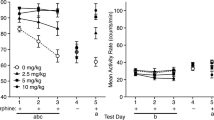Abstract
The involvement of central endogenous opioids in swim-induced antinociception in mice is well documented. The response is attenuated by central or systemic naloxone, displays two-way cross tolerance with morphine and is correlated with apparent occupation of central opiate receptors by endogenous ligands. Swim-induced antinociception was utilised as an in vivo model of endogenous opioid function to investigate a possible protracted functional change in endogenous opioid release or inactivation following chronic opiate treatment. Antinociceptive responses (tailflick latency) to morphine (4.4 mg/kg, SC) and swimming were determined at various times following chronic methadone (24 days treatment, 102 mg/kg day in drinking water for the last 20 days) and chronic morphine (1 g/kg sustained release) treatment. In both experiments, parallel recovery from cross tolerance was observed for morphine-and swim-induced antinociception. These results were consistent with the view that no protracted functional change in the release or inactivation of endogenous opioids had occurred following chronic opiate treatment.
Similar content being viewed by others
References
Chance WT, Schechter MD (1979) Autoanalgesia: blockade by yohimbine. Eur J Pharmacol 58:89–90
Chesher GB, Chan B, Whaite C (1980) Stress-induced analgesia in mice. In: Peck C, Wallace M (ed) Problems in pain. Pergamon Press, Sydney, pp 34–46
Childers SR, Simantov R, Snyder SH (1977) Enkephalin: radioimmunoassay and radioreceptor assay in morphine dependent rats. Eur J Pharmacol 46:289–293
Chipkin RE, Rosecrans JA (1978) Aversiveness of oral methadone in rats. Psychopharmacology 57:303–310
Christie MJ (1982) Regional specificity of changes in [3H] leu-enkephalin binding associated with warm water swimming in mice. Neurosci Lett 33:197–202
Christie MJ, Chesher GB, Bird KD (1981) The correlation between swim-stress induced antinociception and [3H] leu-enkephalin binding to brain homogenates in mice. Pharmacol Biochem Behav 15:853–857
Christie MJ, Chesher GB, Trisdikoon P (1982) Tolerance and morphine cross tolerance resulting from physiological release of endogenous opiates. Life Sci 31:839–847
Collier HOJ, Francis DL, Schneider C (1972) Modification of morphine withdrawal by drugs interacting with humoral mechanisms: some contradictions and their interpretation. Nature 237:220–223
Dum J, Meyer G, Hollt V, Herz A (1979) In vivo opiate binding unchanged in tolerant/dependent mice. Eur J Pharmacol 58:453–460
Fratta W, Yang H-YT, Hong J, Costa E (1977) Stability of metenkephalin in brain structures of morphine-dependent or foot shock-stressed rats. Nature 268:452
Goldstein A (1978) Endorphins: physiology and clinical implications. Ann NY Acad Sci 311:49–58
Hamburg M, Tallman JF (1981) Chronic morphine administration increases apparent number of alpha2-adrenergic receptors in rat brain. Nature 291:493–495
Hollt V, Haarmann I, Przewlocki R, Jerlic M (1980) Long-term treatment of rats with morphine decreases in vitro biosynthesis in and release of beta-endorphin from intermediate/posterior lobes of pituitary. In: Costa E, Trabucchi M (ed) Neural peptides and neuronal communication. Raven Press, New York, pp 399–407
Hollt V, Wuster M (1978) The opiate receptors. In: Herz A (ed) Developments in opiate research. Marcel Dekker, New York, pp 1–65
Kitano T, Takemori AE (1979) Further studies on the enhanced affinity of opioid receptors for naloxone in morphine-dependent mice. J Pharmacol Exp Ther 209:456–461
Lewis JW, Sherman JE, Leibeskind JC (1981) Opioid and non-opioid stress analgesia: assessment of tolerance and cross-tolerance with morphine. J Neurosci 1:358–363
Malfroy B, Swerts JP, Guyon A, Roques BP, Schwartz JC (1978) High affinity enkephalin degrading peptidase in mouse brain and its enhanced affinity following morphine. Nature 276:523–526
Marshall I, Phillips DGL, Nasmyth PA (1981) Calcium ions, morphine tolerance and noradrenergic transmission in the mouse vas deferens. Eur J Pharmacol 75:205–213
Miller RR (1966) Simultaneous statistical inference. McGraw-Hill, New York
Morley JE, Levine AS (1980) Stress-induced eating is mediated through endogenous opiates. Science 109:1259–1260
Osborne H, Herz A (1980) K+-Evoked release of met-enkephalin from rat striatum in vitro: effect of putative neurotransmitters and morphine. Naunyn-Schmiedeberg's Arch Pharmacol 310:203–209
Singh JM (1975) Methods to induce methadone addiction in rats. In: Ehrenpreis S, Neidle A (eds) Methods in narcotics research. Marcel Dekker, New York, pp 311–319
Wikler A (1980) Opioid dependence: mechanism and treatment. Plenum Press, New York, p 47
Wuster M, Schulz R, Herz A (1980) Inquiry into endorphinergic feedback mechanisms during the development of opiate tolerance/dependence. Brain Res 189:403–411
Author information
Authors and Affiliations
Rights and permissions
About this article
Cite this article
Christie, M.J., Chesher, G.B. & Bird, K.D. No evidence for a protracted change in endogenous opioid activity following chronic opiate treatment in mice: parallel recovery of cross tolerance to stress and morphine antinociception. Psychopharmacology 82, 378–381 (1984). https://doi.org/10.1007/BF00427689
Received:
Accepted:
Issue Date:
DOI: https://doi.org/10.1007/BF00427689




